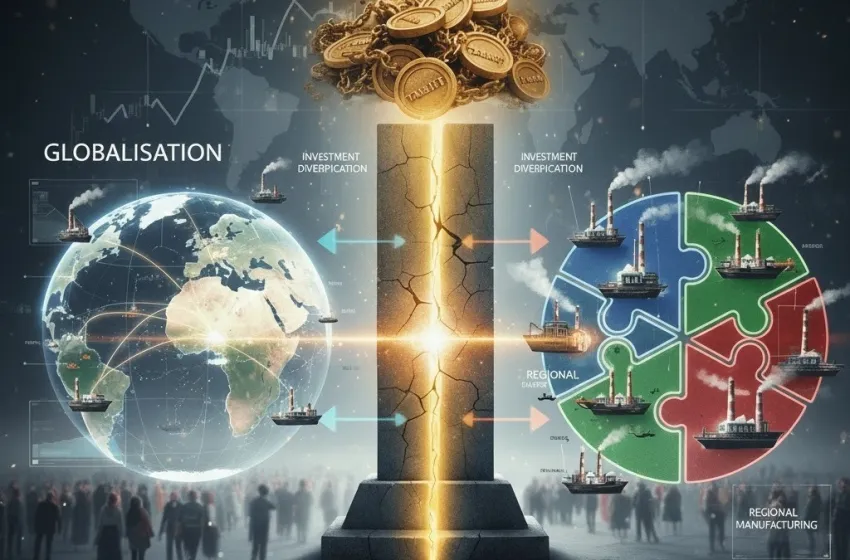Analyzing the shift away from a single global supply chain to regional economic zones
The world is undergoing a significant economic transformation. After decades of relentless globalization, characterized by the integration of international markets, the late 2010s and early 2020s ushered in a noticeable shift toward deglobalization. This counter-trend, driven by geopolitical tensions, the COVID-19 pandemic, technological shifts, and a rise in economic nationalism, is fundamentally reshaping international commerce. This transition is marked by the proliferation and strengthening of trade blocs and the consequential economic fragmentation of the global economy.
This comprehensive analysis delves into the nuances of this economic re-ordering, particularly focusing on the shift away from a single global supply chain to more self-sufficient regional economic zones and its effect on trade and investment. It explores the mechanisms driving this change—such as the renewed importance of national security and supply chain resilience—and examines the multifaceted economic consequences for nations and businesses alike.
Understanding the Retreat: The Forces Behind Deglobalization
Deglobalization is not merely a slowdown in international trade, a phenomenon some economists term "slowbalisation," but a structural change involving the reduction in the degree of global interdependence. It manifests as declining cross-border flows of goods, services, capital, and labor relative to global output, or, more specifically, a deliberate political choice to prioritize domestic and regional economic ties over purely global ones.
The drivers of this retreat are complex and interconnected:
- Geopolitical Conflicts and National Security: Rising tensions between major economies (e.g., US-China) have made high economic interdependence a strategic vulnerability. Governments are increasingly concerned about relying on potential rivals for critical goods like semiconductors, pharmaceuticals, and rare earth elements. This has led to policies promoting "reshoring" and "friend-shoring," where production is moved either back home or to politically aligned nations.
- Supply Chain Vulnerabilities: The COVID-19 pandemic and events like the Suez Canal blockage exposed the fragility of lean, hyper-efficient global supply chains. A single point of failure could halt production worldwide. The demand for resilience has now begun to outweigh the pursuit of pure cost efficiency.
- Technological Shifts: Advances in automation and additive manufacturing (3D printing) are reducing the dependence on low-wage labor in distant countries, making regional manufacturing closer to end markets more economically viable.
- Economic Inequality and Populism: The distributional effects of hyper-globalization—where certain domestic sectors and workers suffered from import competition—fueled a populist backlash, leading to a political environment favorable to protectionist policies.
The Rise of Regional Blocs and Economic Fragmentation
In this new environment, the shift is not toward pure isolation, but toward regionalization. Nations are increasingly turning to formalized trade blocs—regional comprehensive economic partnerships—to secure their supply chains and access to markets with trusted partners.
The Mechanics of Trade Blocs
Trade blocs—such as the European Union (EU), the United States-Mexico-Canada Agreement (USMCA), the Comprehensive and Progressive Agreement for Trans-Pacific Partnership (CPTPP), and the Regional Comprehensive Economic Partnership (RCEP) in Asia—create integrated, large-scale markets that benefit from:
- Internal Trade Liberalization: They offer preferential trade terms, often involving the elimination or significant reduction of tariffs and non-tariff barriers among member states.
- Common External Tariffs (in customs unions): This structures trade relations with non-member states, effectively creating an economic barrier against the rest of the world and encouraging intra-bloc trade.
- Harmonization of Standards: Blocs often standardize regulations, intellectual property protections, and labor laws, further lowering the cost and complexity of internal commerce.
The Phenomenon of Economic Fragmentation
The core consequence of strengthening trade blocs amid deglobalization is economic fragmentation. The world economy is bifurcating into distinct, often geopolitically aligned, ecosystems (e.g., a "West" bloc centered around the US and EU, and an "East" bloc centered around China).
- Trade Diversion vs. Trade Creation: While a trade bloc creates new trade among its members (trade creation), it can also divert trade away from more efficient non-member producers toward less efficient internal producers (trade diversion). This results in a loss of global efficiency, as the principle of comparative advantage is constrained by political boundaries.
- Dual Ecosystems: Businesses operating globally are increasingly forced to navigate distinct regulatory, technological, and supply chain ecosystems. For instance, a tech company may need to develop one set of products and supply chains compliant with standards in the US bloc and a separate, non-interoperable set for the China bloc. This duplication of effort significantly raises costs and slows innovation across the board.
- The Squeezed Middle: Countries that remain "unaligned" or are positioned between the major blocs (like Mexico, Vietnam, and Turkey) are becoming critical connecting countries for the reconfiguration of supply chains. They see strong Foreign Direct Investment (FDI) inflows as companies seek to diversify their production locations, a phenomenon often called "near-shoring" or "de-risking."
Impact on Trade, Tariffs, and Investment
The twin forces of deglobalization and rising trade blocs have profound consequences for global trade flows, the use of tariffs, and international capital movement.
The Evolving Role of Tariffs
The hyper-globalization era was marked by a steady decline in global tariffs. The current trend is reversing this. Tariff effects are now being strategically deployed, not just for revenue or protecting infant industries, but as a geopolitical weapon:
- Bilateral Tariffs as Policy Tools: The US-China trade war saw the imposition of significant reciprocal tariffs on hundreds of billions of dollars worth of goods. These tariffs directly increase the cost of doing business across the geopolitical divide, forcing companies to restructure their sourcing.
- Anti-Dumping and Countervailing Duties: The use of protectionist measures like anti-dumping and countervailing duties is on the rise, often invoked under the guise of national security.
- Internal Tariff Reduction: Conversely, within trade blocs, the reduction of internal tariff effects is the primary mechanism for fostering deeper integration. For non-members, the tariff differential acts as a powerful incentive to invest in a bloc member country to access the preferential market—a process known as tariff-jumping FDI.
Redrawing the Map of Global Investment
International capital flows, particularly FDI, are seeing a clear shift toward investment diversification and regional focus.
- Intra-Bloc Investment Surge: The relative security and preferential market access within trade blocs make internal investment more attractive. This is visible in the increased ratio of intra-bloc to inter-bloc FDI flows. For example, investment among European Union members or within the USMCA framework may become relatively more important than investment flowing between the US and China.
- Supply Chain Relocation FDI: Companies are engaging in investment diversification by moving core production capabilities to multiple locations to reduce reliance on a single geographic area (e.g., China-plus-one strategies). This has resulted in a boom in FDI for strategically placed countries, often members of a trade bloc, that are positioned near major consumer markets—a direct catalyst for regional manufacturing growth.
- Focus on Critical Sectors: Governments are also using subsidies and investment restrictions to guide FDI toward strategically critical domestic and regional industries (e.g., semiconductors, battery manufacturing, electric vehicles). This is industrial policy in a deglobalization context, aiming to secure control over key technological inputs.
Regional Manufacturing and Supply Chain Resilience
One of the most tangible economic effects of deglobalization is the resurgence of regional manufacturing and the transformation of supply chain management.
The Shift from "Just-in-Time" to "Just-in-Case"
The old paradigm of "Just-in-Time" (JIT) inventory management, which prioritized minimal stock and maximal efficiency through long, global supply chains, is being replaced by a "Just-in-Case" (JIC) philosophy emphasizing supply chain resilience.
- Local-for-Local Production: Companies are increasingly adopting "local-for-local" models, where production facilities are located within the same trade bloc or geographic region as the final customer. This shortens logistics, minimizes transit risk, and allows for quicker response to regional demand shifts.
- The Cost of Resilience: Regional manufacturing often comes with a higher unit cost due to higher labor and operational expenses compared to traditional offshoring locations. This increase in production cost is the economic price paid for enhanced supply chain resilience and reduced geopolitical risk. These costs may ultimately be passed on to the consumer, contributing to inflationary pressures.
- Digitalization and Automation: The viability of regional manufacturing is intrinsically linked to advancements in automation and digitalization. The use of robotics, AI-driven logistics, and advanced data analytics helps offset higher labor costs, making production in developed trade blocs more competitive.
Investment Diversification and the Search for Redundancy
The strategic goal of investment diversification is to build redundancy into supply chains. This means intentionally developing overlapping sourcing and manufacturing capabilities across different regions.
- The Role of Emerging Markets: Countries like Vietnam, Mexico, India, and Indonesia, which offer competitive costs and are often part of significant trade blocs (or positioned to trade with them), are receiving substantial new FDI to serve as alternative manufacturing hubs. This is directly impacting their domestic economic growth and structural transformation.
- Increased Inventory and Buffer Stocks: Beyond physical relocation, resilience also involves holding larger buffer stocks of inventory and critical components. This acts as a shock absorber against sudden geopolitical or health-related disruptions, but represents a significant cost—in warehousing, insurance, and capital tied up—that effectively acts as a tax on the global economy.
The phenomenon is complex, often characterized more accurately as a re-globalization—a realignment of economic flows along geopolitical lines—rather than a complete retreat. The path forward will be defined by how effectively trade blocs manage to balance internal integration with external competitive pressures, and how quickly companies can complete their investment diversification to build resilient, regional supply chains in the face of persistent economic fragmentation.



































